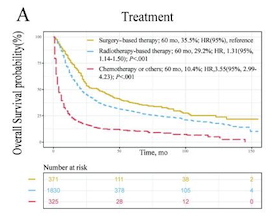Developing a predictive nomogram and web-based survival calculator for locally advanced hypopharyngeal cancer: A propensity score-adjusted, population-based study
DOI:
https://doi.org/10.17305/bb.2023.8978Keywords:
Locally advanced hypopharyngeal squamous cell carcinoma (LA-HPSCC) , nomogram, survival, surgery-based therapy, Surveillance, Epidemiology, and End Results (SEER)Abstract
Understanding the clinical features and accurately predicting the prognosis of patients with locally advanced hypopharyngeal squamous cell carcinoma (LA-HPSCC) is important for patient centered decision-making. This study aimed to create a multi-factor nomogram predictive model and a web-based calculator to predict post-therapy survival for patients with LA-HPSCC. A retrospective cohort study analyzing Surveillance, Epidemiology, and End Results (SEER) database from 2004 to 2015 for patients diagnosed with LA-HPSCC was conducted and randomly divided into a training and a validation group (7:3 ratio). The external validation cohort included 276 patients from Sichuan Cancer Hospital, China. The Least Absolute Shrinkage and Selection Operator (LASSO)-Cox regression analysis was used to identify independent factors associated with overall survival (OS) and cancer-specific survival (CSS), and nomogram models and web-based survival calculators were constructed. Propensity score matching (PSM) was used to compare survival with different treatment options. A total of 2526 patients were included in the prognostic model. The median OS and CSS for the entire cohort were 20 (18.6-21.3) months and 24 (21.7-26.2) months, respectively. Nomogram models integrating the seven factors demonstrated high predictive accuracy for 3-year and 5-year survival. PSM found that patients who received surgery-based curative therapy had better OS and CSS than those who received radiotherapy-based treatment (median survival times: 33 months vs 18 months and 40 months vs 22 months, respectively). The nomogram model accurately predicted patient survival from LA-HPSCC. Surgery with adjuvant therapy yielded significantly better survival than definitive radiotherapy. and should be prioritized over definitive radiotherapy.
Citations
Downloads

Downloads
Additional Files
Published
Issue
Section
Categories
License
Copyright (c) 2023 Sihao Chen, Shanshan He, Dan Wang, Yi Liu, Shilong Shao, Li Tang, Chao Li, Qiuling Shi, Jifeng Liu, Feng Wang, Shichuan Zhan

This work is licensed under a Creative Commons Attribution 4.0 International License.
How to Cite
Accepted 2023-04-06
Published 2023-09-04









